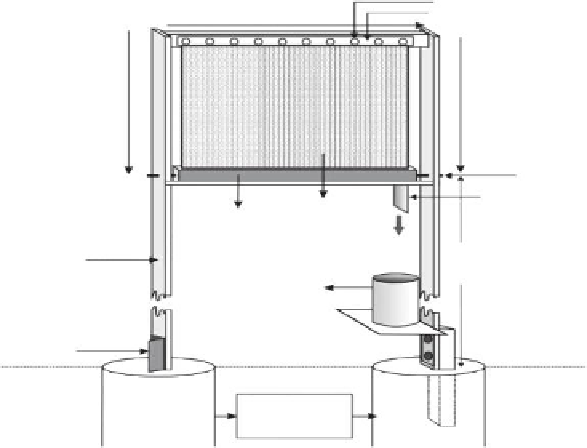Environmental Engineering Reference
In-Depth Information
8 mm bolt and nuts
50 × 50 mm flat
1100 mm
13 mm rod
15 mm copper tube
fixed to gutter
with Pratleys
Net shade or
terramin screen
Gutter: 110 mm
PVC pipe with
stop ends cut in
half
Water
outlet
50 × 25 × 2.5 mm
box rod
1000 mm
or
2000 mm
Tipping bucket
rain gauge
plus data logger
50 × 50 × 50 mm
angle
Ground level
Precast cement
in a 25-liter
plastic drum
FIGURE 29.3
Model of fog collector at Cape Columbine.
fog-capturing equipment at each section. It was essential to approach the project with the
knowledge of the density from different areas of the cloud; the data are necessary to pro-
ceed with further investigation of the equipment and its spatial distribution in designing a
capture station (AWC). Today's Doppler radar is capable of providing such information for
many areas. The approach taken to measure data bearing on the density of the fog present
was previously made by direct visual observation and was enhanced by newer remote
sensing methods. The second data logger counter was equipped with highly sensitive low
detectors capable of working at predetermined pressures and emitting pulses counted
with every 0.5 liters of water that passed through it. The matrix network of AWC reported
their data to the weather station, sent via a GPRS (precursor to 4G) wireless signal to a
server located in the Station Control Research Center (Tenerife base station). This station
allows watching all capturing deployments in a timely manner and analyzing the data
collected from the comfort of an ofice desk, with the assurance that the measurements are
reliable and that the measurements of the captured water are not affected by any evapora-
tion effects. Thus, for the irst time in many years, we can complete a database populated
with real and meaningful data about what happens with particular fog banks or rain, and
the percentage of what is captured. The observations provided a data series, now available
and offered to investigators to try to make a comparative analysis between varying situ-
ations, conditions, and ensuing results. These inquiries have set clear lines for the analy-
sis, including a methodological plan that achieved milestones for the research group and
meaningful consequences that clearly identiied what variables affect harvesting regimes
and which have not, at least to a irst approximation, which are of importance to future
research. It has gone from no reliable data to a large volume of data present.
The data analysis began at once to detect seasonal conditions on AWC that, to date, has
not been previously detected, including overloads such as overlowing collection systems,
discrete behaviors when rainfall exceeds certain values, designs of new anchoring sys-
tems developed to sustain failure against strong winds, decantation, and ineficiencies

